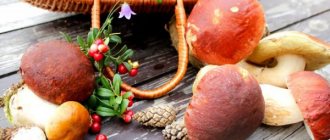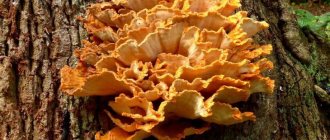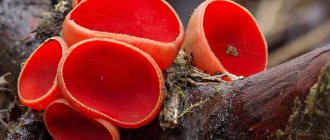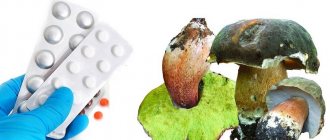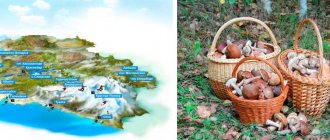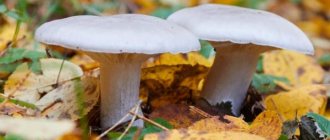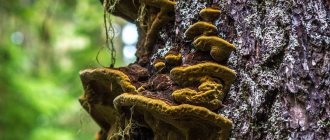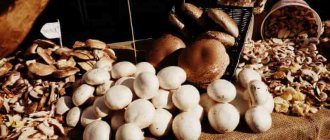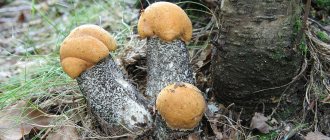Mushroom history of Crimea
The season usually begins after the onset of Indian summer, but in general, they can be collected all year round, at any time. Although there are a lot of mushrooms on the peninsula, they have never been considered the main food. Therefore, only amateurs collected them. This attitude continued into the 20th century. Afterwards, Mediterranean cuisine came into fashion, including various mushroom sauces. People have reconsidered their attitude towards food. Thus, Crimean mushrooms began to enjoy great success among the population of the peninsula.
Poisoning by poisonous species of talkers
Symptoms of poisoning by the toxin muscarine, which is contained in the pulp of poisonous mushrooms, appear within 3 hours. They are expressed as follows:
- gastrointestinal dysfunction, severe nausea, vomiting, diarrhea, cramps in the stomach and intestines are the main symptoms;
- disruptions in the functioning of the cardiovascular system, they are accompanied by a sharp decrease in blood pressure, sinus bradycardia;
- increased sweating;
- increased salivation;
- difficulty breathing, bronchospasms and asthma.
The most dangerous mushroom from the govorushka family is considered to be the waxy govorushka. Its pulp has a deceptively pleasant taste and aroma. Often the symptoms of poisoning do not appear in any way. However, on the fifth day the person dies from acute renal failure.
Mushrooms of Crimea: photos, description, places of growth
Each year, the season begins and ends differently for specific species. “Where to pick mushrooms?” – there is no definite answer to this question, since there are a huge number of them on the peninsula. Many of them are considered edible. There were also poisonous species. But mostly the demand is for the familiar and familiar mushrooms that grow in other regions.
Features of preparation and use in cooking
It is important not only not to make mistakes when picking mushrooms and to avoid poisoning from inedible or poisonous specimens, but also to know how to properly prepare certain forest products. This is especially true for conditionally edible mushrooms, which are never eaten raw or not properly prepared.
There have been known cases of poisoning with this talker, so you need to pay attention to some features of its preparation:
- It is undesirable to use already overgrown mushrooms; it is better to take young specimens for cooking;
- the stem of the talker is a bit harsh, it is better to cut it off right away using only the cap;
- Pre-boiling (20-30 minutes) is mandatory. There is no need to waste time on such preparation, because this can avoid accidental poisoning;
- talkers boil down very much, so this must be taken into account when calculating the required amount of mushrooms when preparing dishes;
- After boiling the talkers, they also require additional heat treatment.
Advice.
The decoction from the talkers is not used in the future. It's better to just pour it out. The gray talker is used for preparing a wide variety of dishes. And as a basis you can take almost any recipe where mushrooms are one of the ingredients. You can fry it, salt it, pickle it and store it in dried form for the winter. This mushroom is added to soups, main courses are prepared with it, and used as fillings for pies and other types of baked goods. The govorushka goes well with meat, cereals, and various vegetables.
Crimean steppe mushrooms: single barrel
This is another interesting representative of the mushroom world, which is often called the crane. Loves to grow among grass in steppe areas. It's just hard to find a single barrel. Local residents (near Simferopol) are accustomed to calling it differently, each with its own associations. For example, you can often hear the word “ungulate”. This name was given to it because of its woody stem. Many people call it duck because of its growth characteristics. She stands as if “waddling”, like a tired bird. Sometimes you can stumble upon a whole “vegetable garden” of these mushrooms.
A single barrel is very similar to an oblique funnel, which has rolled edges of the cap. The blades are wide, white and sparse. But the main feature of this mushroom is that it grows precisely in the grass, on the prickly tartar or eryngium field. The season usually starts in May and ends in November. But there were cases when she was found in January. For food it is used freshly prepared; many people prefer to pickle it.
Since the steppe zone of the peninsula occupies more than half of the territory, mushrooms of this area include honey mushrooms, boletuses, boletus, boletus and saffron milk caps. These species are no different from their counterparts, except that they grow in grass and not under trees. The most popular steppe mushrooms of the Crimea are oyster mushrooms and single-barrel mushrooms. They belong to the same family. But they have their own characteristics. Although many people mistake them for one species. The single barrel grows in the bare steppe, which is completely devoid of trees. But oyster mushrooms live on decaying trunks.
Description
Gray talker is a lamellar mushroom. Belongs to the Ryadovkov family and the Govorushka genus. It is considered a conditionally edible mushroom, that is, it requires preliminary preparation before consumption. It also has other names - it is a smoky or smoky-gray talker. It is also called smoky row.
The gray talker's cap is large and fleshy. It is usually about 5-15 cm in diameter, but sometimes can reach up to 20-22 cm. Its edges are folded, but with age they more often straighten out, and a tubercle appears in the center of the cap. The surface of the skin is matte and velvety, while that of a young mushroom is stickier. The color can vary from gray-ash to darker with a brownish tint, usually lighter at the edges. In rainy weather the cap becomes darker.
Talker
The plates are initially white, then acquire a yellowish-cream tint. Spore powder is whitish in color. The leg of this talker is up to 4-8 cm in height. It is lighter than the cap, quite thick and fleshy, and widens towards the base.
Poisonous Crimean mushrooms
There are approximately 45 species of these. Poisonous mushrooms of Crimea are divided into 5 groups according to their toxicity.
- 5th group: gray entoloma, tiger row, flat-capped champignon. Symptoms of mild poisoning begin between 30 minutes and 5 hours after consumption. The malaise lasts up to a week.
- 4th group: inky and shaggy dung beetles. Poisoning occurs when drinking alcohol at the same time. Therefore, you should not drink it for three days after the mushrooms have been eaten.
- 3rd group: talkers (pale, reddish, orange-red and waxy). All symptoms of poisoning begin 15 minutes after eating mushrooms. Sometimes they lead to the death of a person.
- 2nd group: red and panther fly agarics. Poisoning can often result in death.
- Group 1 - the most poisonous mushrooms, fatal to humans. These include: pale toadstool, spring white and green fly agarics and cherry-brown silverfish. Symptoms begin to appear almost immediately after consuming them.
Although all these mushrooms are poisonous, they can also be useful for humans. Some of them are used by pharmacists to prepare various medicines and are sometimes included in herbal teas for brewing. Of course, the dosage is the minimum.
Mushrooms with vegetables and rice
To prepare this dish for 1 kg of talkers you need to take 1 liter of meat broth, 200 g of rice, 100 g of hard cheese, 200 g of tomatoes, 100 g of green peas, 2 onions and bell peppers each, 2-3 cloves of garlic, fresh parsley, a little butter and vegetable oil for frying, spices, salt.
Preparation:
- Boil the mushrooms, drain them in a colander, add a little salt and fry in a frying pan in oil.
- Chop the onion and garlic, fry separately in another frying pan, then combine them with the mushrooms and simmer all together for about 5-7 minutes.
- Then transfer the contents of the frying pan into a saucepan, add rice and pour in broth. Then add green peas and chopped tomatoes and peppers in any way. Cook all this until the rice is ready.
- When the dish is ready, add grated cheese, fresh parsley, butter and spices to the pan.
There are many other recipes for mushroom dishes in which the talker is perfect as the main ingredient. You just need to learn how to correctly identify it among forest gifts and do not forget about preliminary boiling.
Where to pick mushrooms
Many people prefer the Crimean mountains, where the famous porcini mushroom is most often found. The Ai-Petri Yayla enjoys great success. There are also many of them on the flat tops of mountain ranges. And the forests near Mount Demerdzhi - in Luchistoye - are considered excellent places for “silent hunting”.
There are many good places near Sevastopol - where the forest stretches to Bakhchisarai. In the east of the peninsula, mushrooms are collected from Feodosia to Old Crimea. The steppe zone is also rich in them - near the Donuzlav and Sasyk estuaries. The largest number of mice can be found in the area of Kolchugino and the Crimean Observatory. Saffron milk caps are found near Rybachy, and chanterelles are collected in Mramorny. Butterflies are most often found in Stroganovka and the Zelenogorsk region.
Mushroom ethics
Lovers of “silent hunting” have their own ethics. You cannot kick mushrooms even if they are of no interest. Someone else may need them. Ideally, collection occurs in baskets woven from twigs. This is due to the fact that plastic buckets and bags do not allow air to pass through, and the collected mushrooms may not make it home. They need to be cut off with a knife, close to the ground, so as not to damage the roots.
You cannot pull them out of the mycelium and tear the moss. This damages and destroys the roots. Under the bright sun, the mycelium dries out and dies. The most favorable time for collection is after a warm rain, especially if it happened at night. In order to preserve the mycelium, a rotten specimen that comes across the path is broken into small pieces and scattered around.
Cooking talkers
When talker mushrooms are available, most recipes require boiling them. This is done as follows.
- The prey is cleared of forest deposits and carefully washed with cold water.
- Mushrooms are transferred to salted water (one spoon per liter).
- We wait for it to boil and time it for half an hour.
After this, you can fry the talkers, stew them with vegetables, or make pies.
How to avoid mushroom poisoning
The main causes of poisoning are caused by improper collection and storage. Mushrooms growing in Crimea also have false counterparts. They are difficult to distinguish from edible species. The market even has special expertise that is available to anyone to check their trophies.
To prevent poisoning, when purchasing mushrooms, you need to carefully examine them to see if they are poisonous. It is better to simply throw away the doubtful ones. Their age differences are also important. Old and wilted mushrooms are difficult to recognize as to whether they are edible or poisonous. If there is even the slightest doubt, it is better to simply refuse them.
Mushrooms must be processed and prepared on the day of collection. Otherwise, toxic substances may form in them. First, you need to boil them in water for ten minutes and only then fry and re-cook them. Some mushrooms in their raw form, if you simply lick your tongue, leave a bitter taste on it. These can be thrown away immediately - they are poisonous. Even if they look edible.
Useful properties of the mushroom
Thanks to its rich chemical composition, smoky grass has a beneficial effect on the human body.
- The product has the following beneficial properties:
- improves the functioning of the digestive system;
- strengthens the immune system;
- reduces the risk of malignant tumors;
- enriches the body with vitamins and nutrients;
- promotes the elimination of toxins;
- has an antibacterial effect;
- stimulates metabolism;
- promotes muscle recovery after physical activity;
- tones the body and improves mood;
- strengthens bones and tooth enamel;
- has a beneficial effect on brain function;
- prevents the occurrence of diseases of the cardiovascular system.

